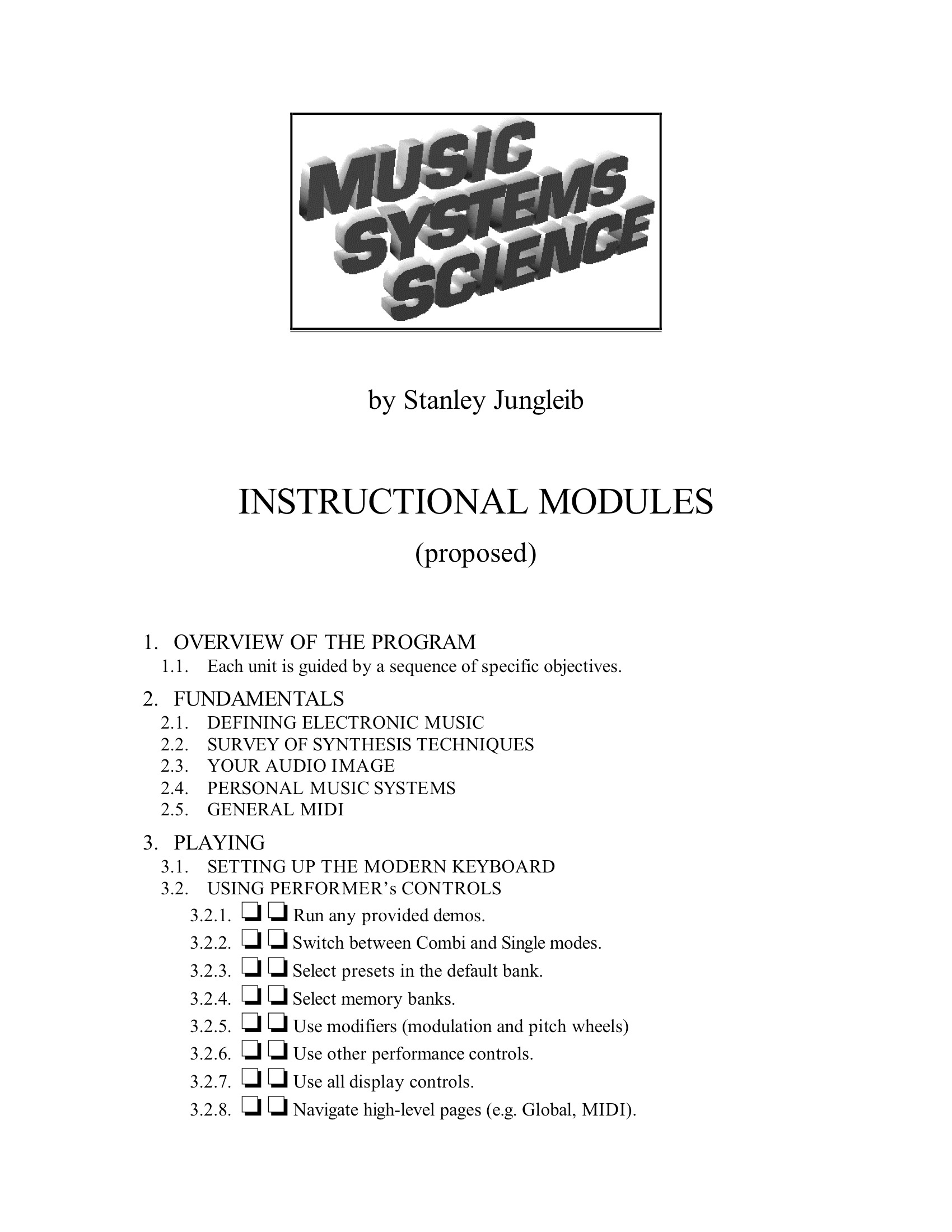
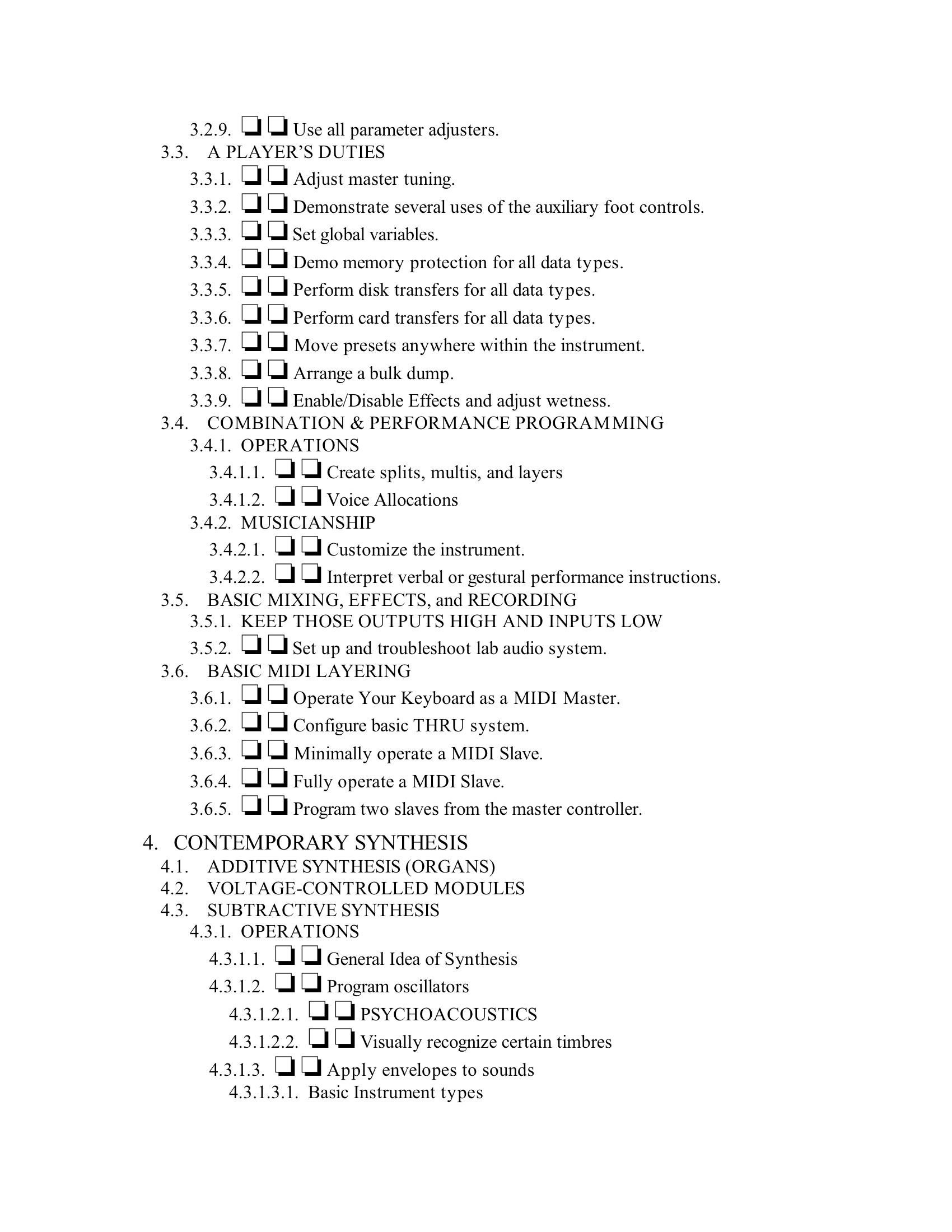
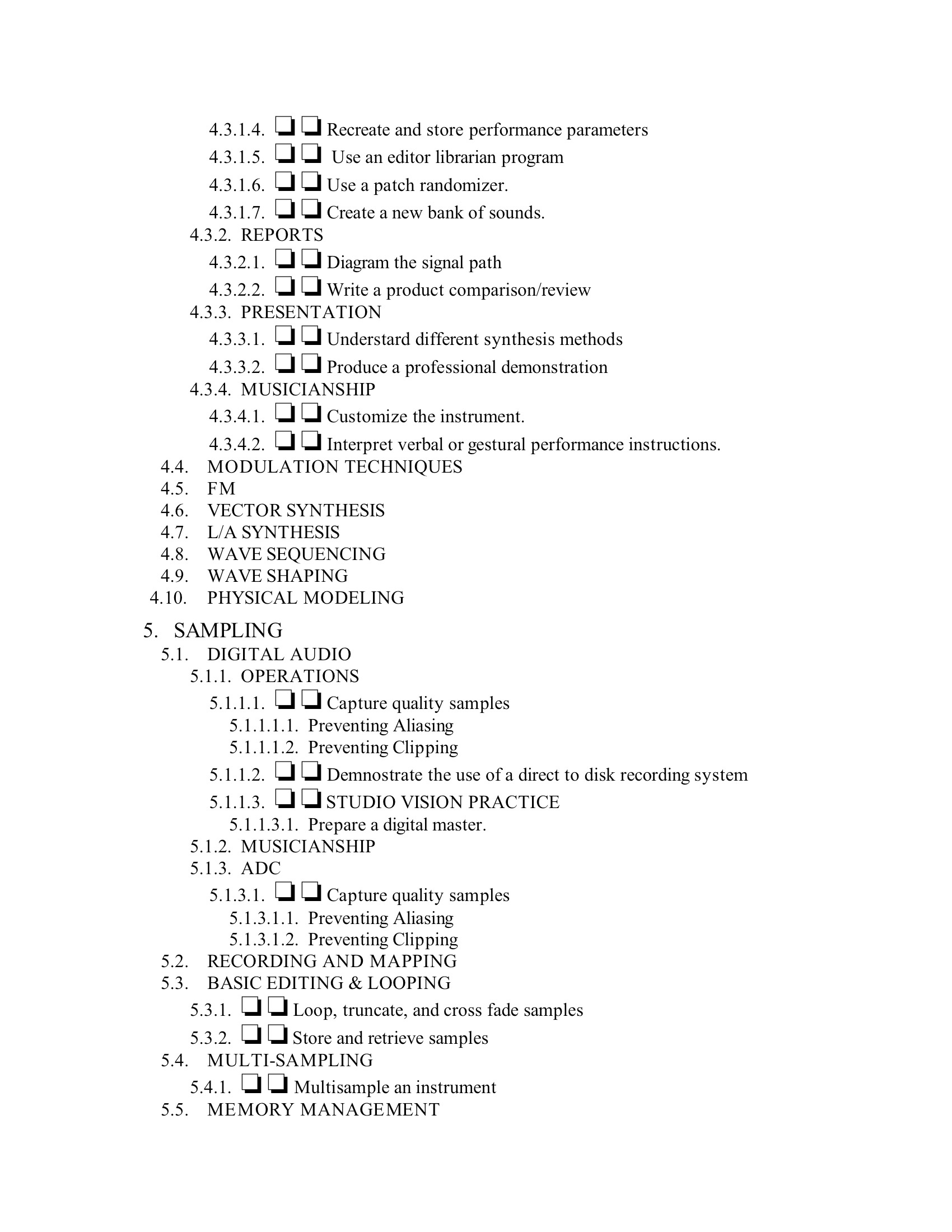
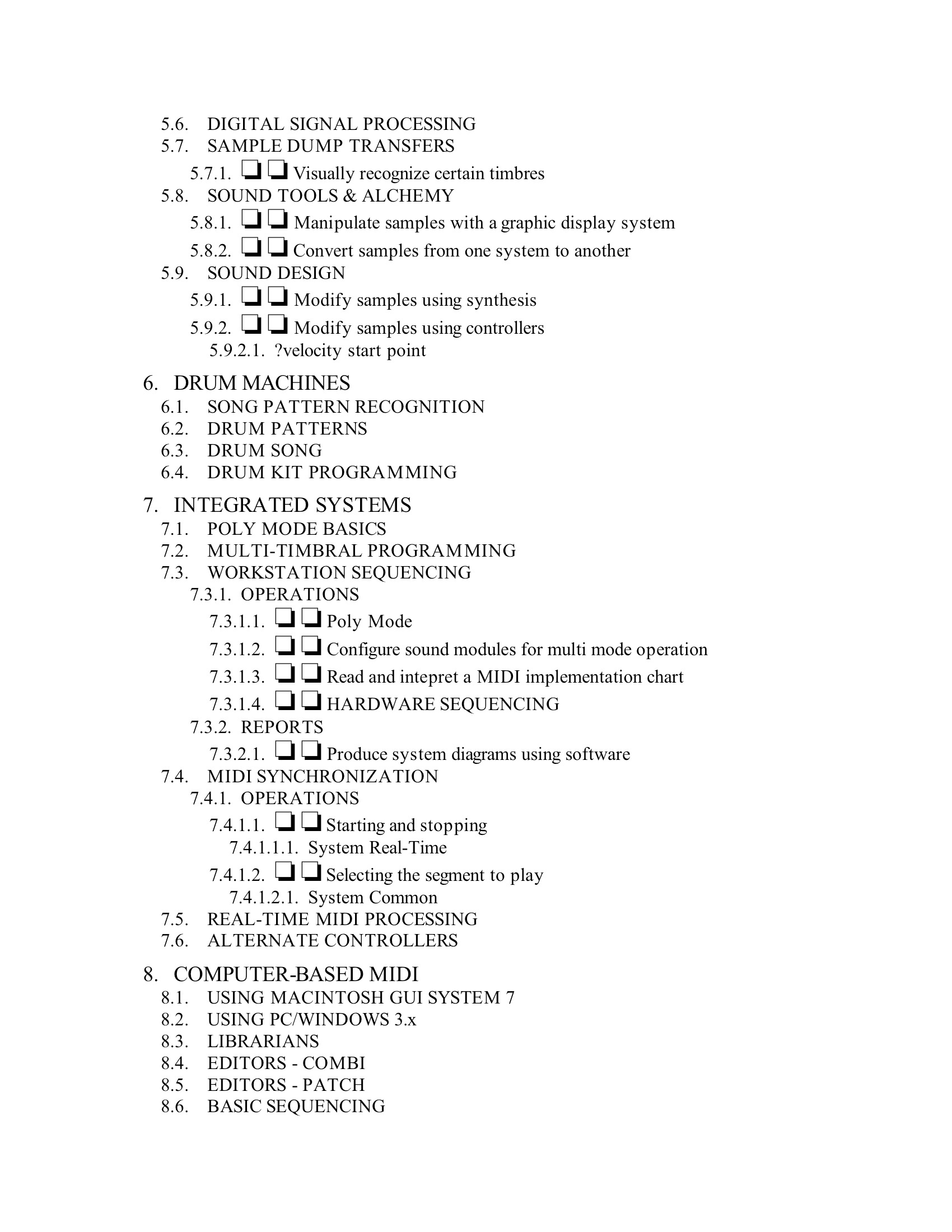
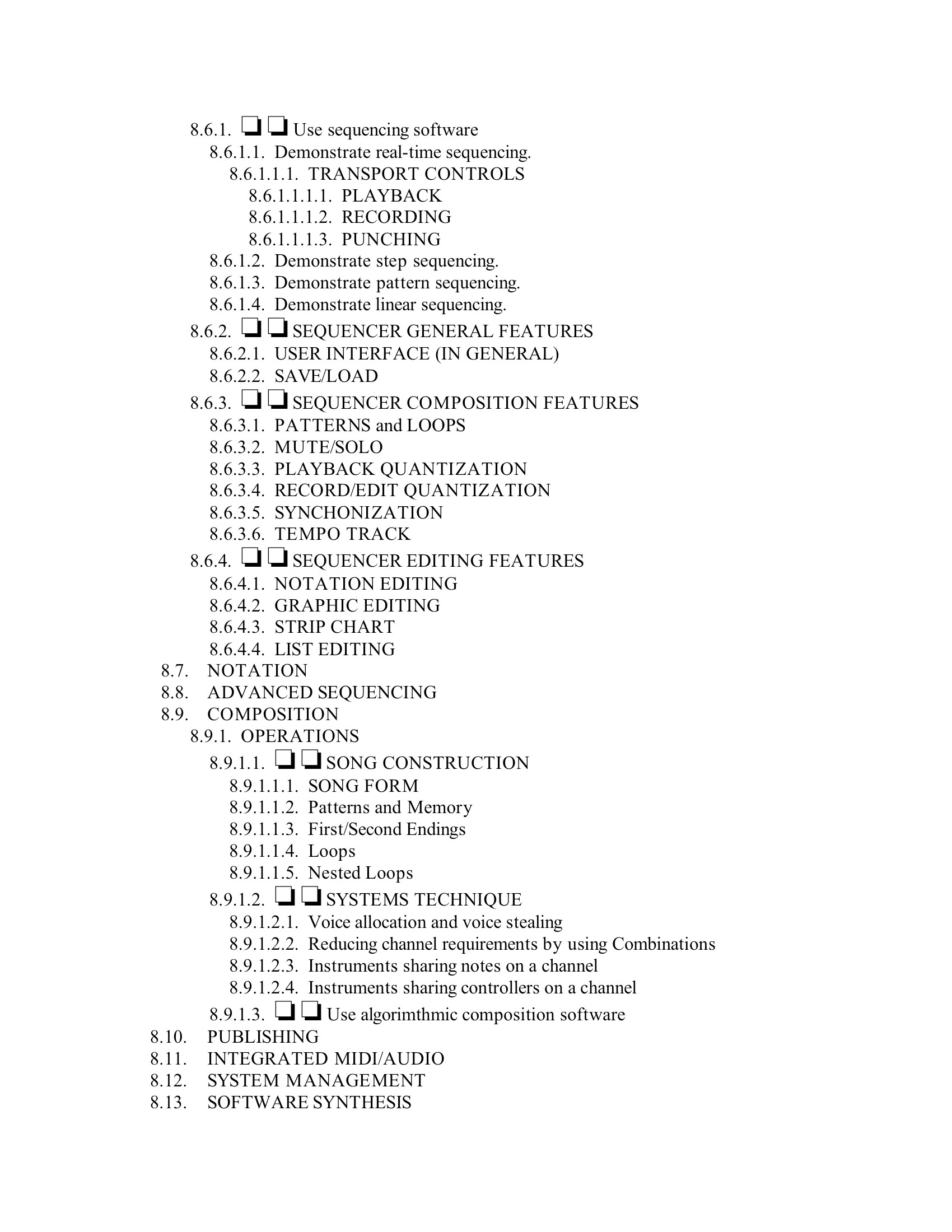

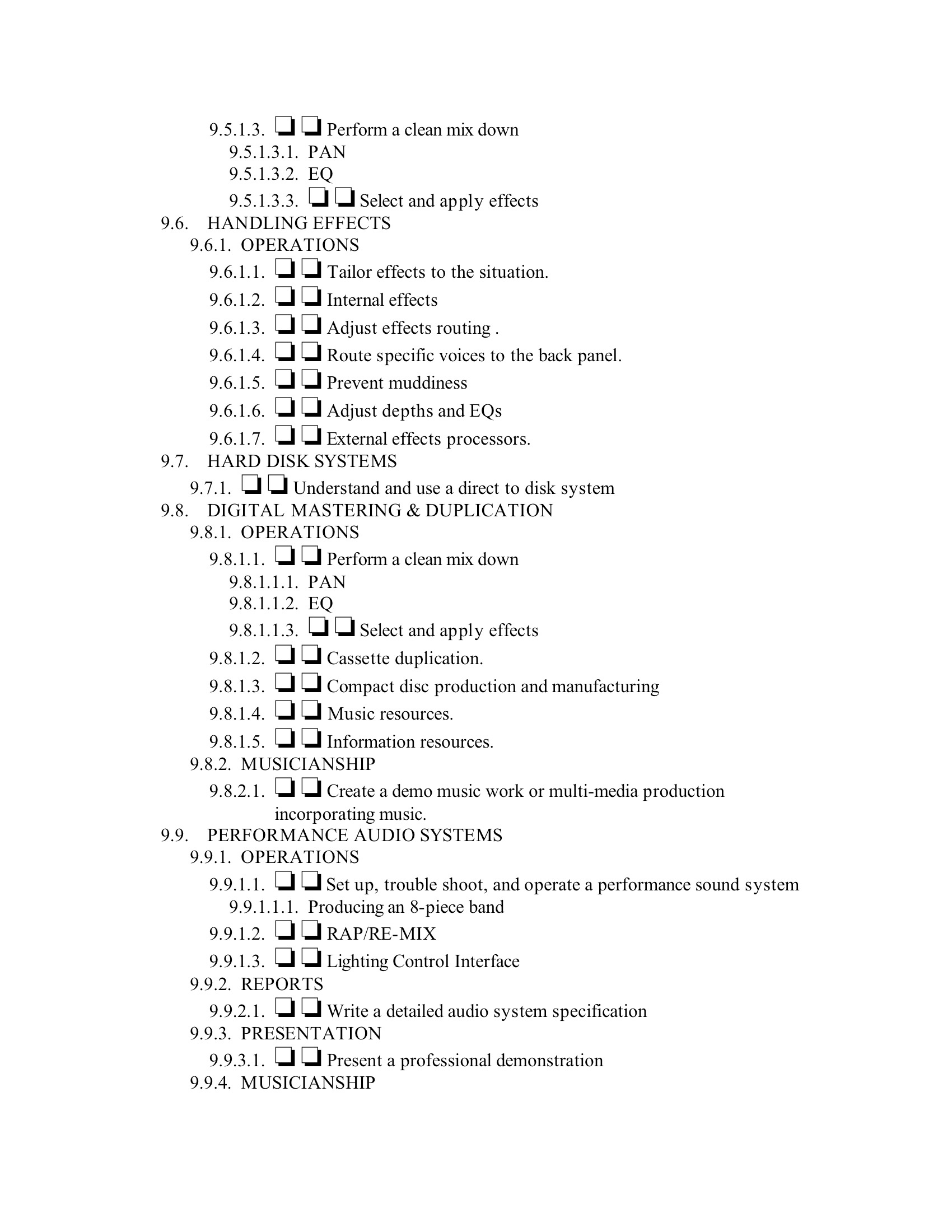
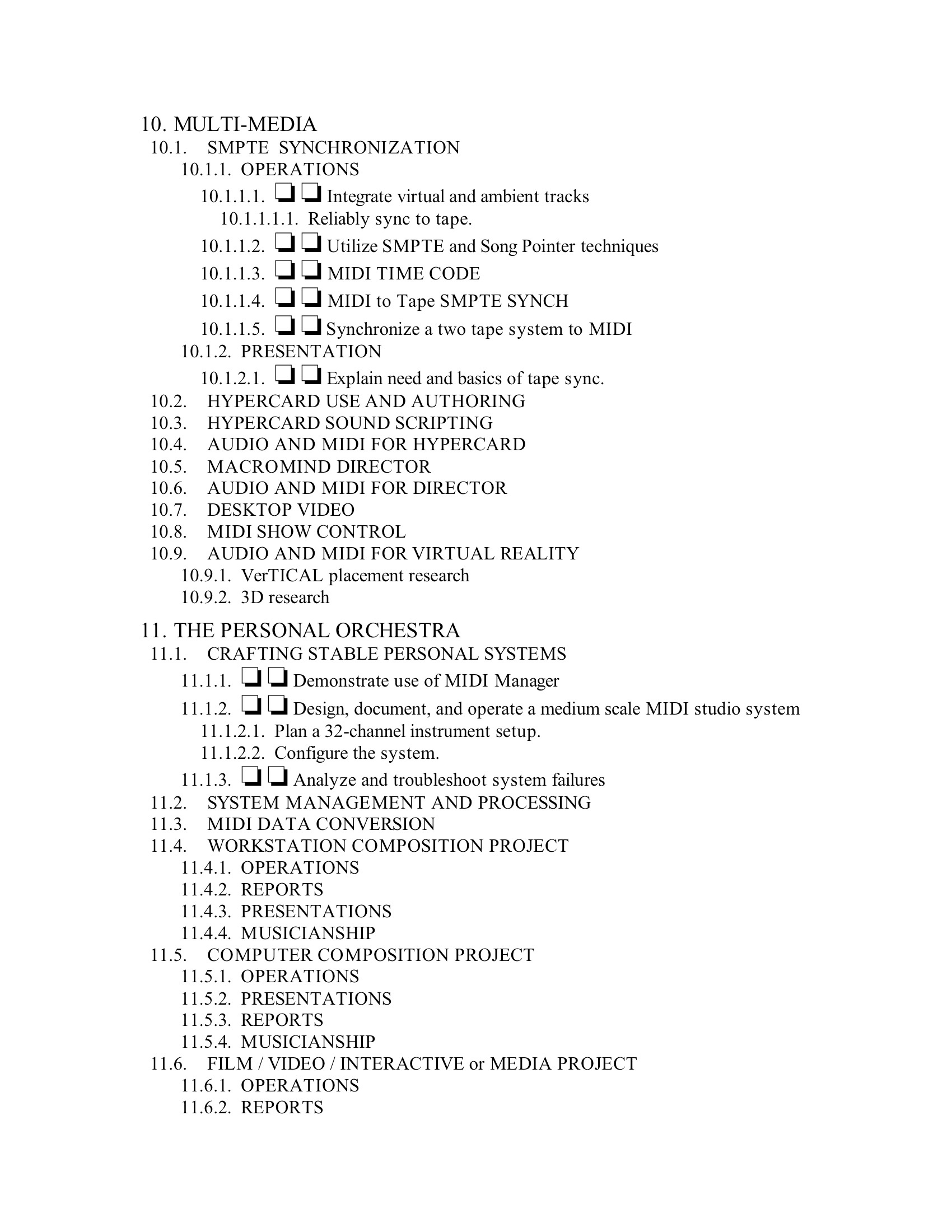
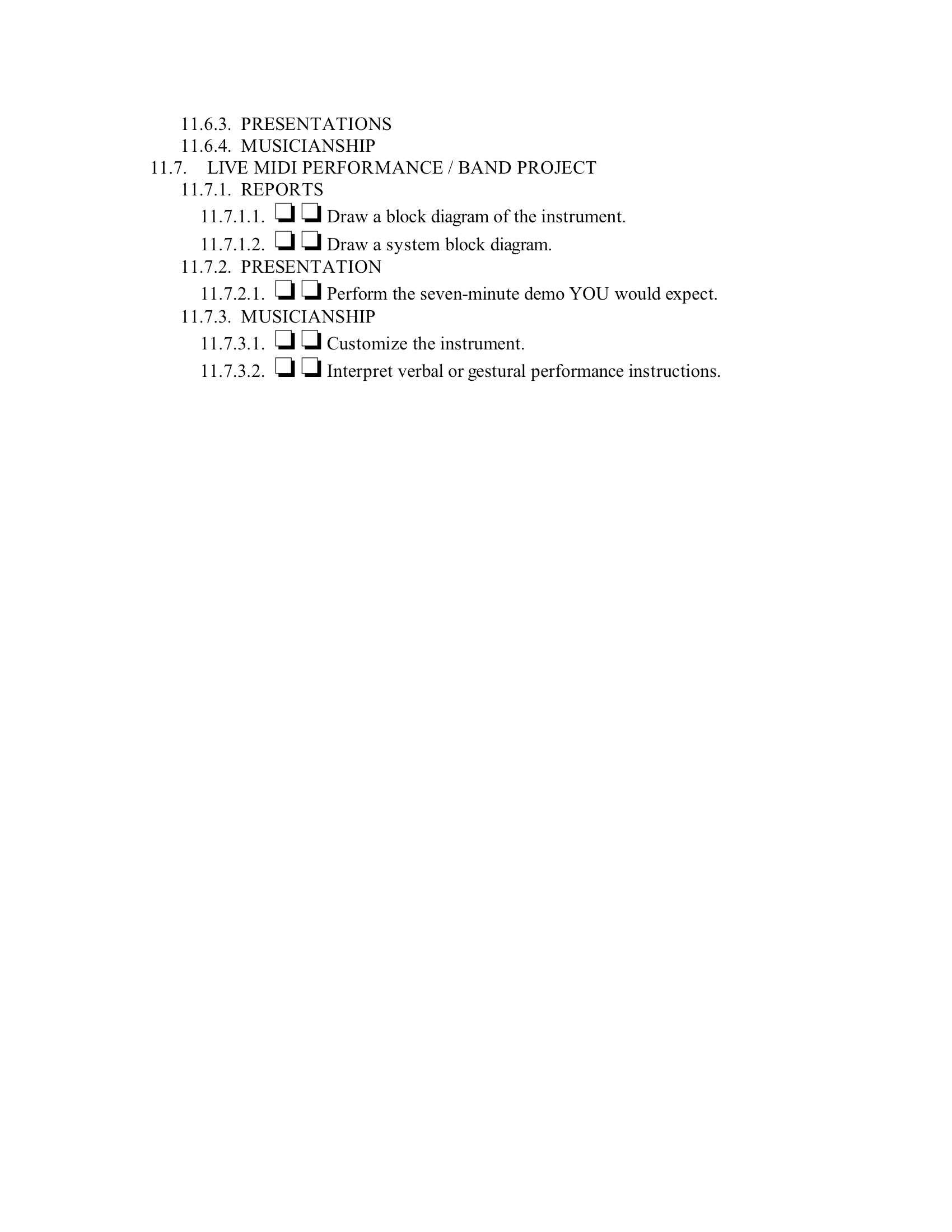
Credibility Pursuing Incredibility





















































































































Revised 20120512
In posting this seminal article, I just noticed it contains a song instrument-to-channel mapping idea that—as was the entire spec-came from Roland. I came to utterly dislike this idea (consistently, I wrote against it in General MIDI) so am pretty sure I’m responsible for it going away.
Also, for some utterly strange, baseless reason—maybe just to see if we were actually reading it, or maybe they wanted a proprietary octave offset—Roland originally wrote in a Middle C of 72—violating MIDI 1.0 itself. I do remember going berserk about this, and Dave talked them back to 60.
————–
Dave Kusek
Passport Designs
&
Stanley Jungleib
MIDIWorld
ABSTRACT
General MIDI is a current MMA proposal which for the first time specifies a fixed set of preset sound data as well as certain features of MIDI playback instruments. Multi-timbral sequences, for example, can be programmed for a General MIDI instrument and they will always play correctly on any General MIDI instrument without user intervention. The concept is simple. The implications of having a known MIDI target are profound in terms of bringing MIDI into the multi-media and consumer arenas.
OVERVIEW
One of MIDI’s fundamental principles is modularity. This was achieved by conceptually dividing the programmable performance synthesizer into separate controller and sound modules. The controller produces note data and the sound module speaks according to however it has been programmed. The sound module doesn’t care what type of device produces the controlling data.
This is a very powerful concept which allows you to create large compositions with the aid of a sequencer for storing the separate parts, rather than your having to play them all simultaneously from the keyboard. To route the musical parts to the intended instruments and sounds, you create a scheme of channel assignments and preset sound selections. You use the sequencer to allocate data to certain MIDI channels. And you take advantage of the instruments’ “Poly” mode capability to listen selectively to these discrete channels.
This is all well and good, *until* you start to think about playing back your creation on different instruments, or transferring it to a different studio. Or, until you simply decide to replace one instrument with another. The downside of modularity is that since MIDI has been to this point entirely voluntary, there is no industry standard minimum configuration or set of capabilities that one could rely on being in a given synthesizer. For example, there is no similarity between preset numbers and resulting timbres. Other examples of basic incompatibilities are defaults for pitch bend range, modulation effects, octave registration, the number of available voices, timbres, velocity response curves, and the mapping of sounds to MIDI keys by drum “kits.”
By the same token, it is virtually impossible to publish MIDI sequences that will play on popular MIDI synthesizers without requiring a good deal of custom programming. The data has to be made manufacturer and device specific. This limits the availability of MIDI data titles to individual instruments or at best to those of a particular manufacturer, and places an unrealistic burden on the consumer to ensure that the system actually works.
GENERAL MODE
Against this backdrop, the General MIDI (GM) proposal is intended to make it simple for users to operate “turn-key” MIDI music systems. This should help create a mass consumer market for MIDI equipment that is considerably larger than the present one. The consumer market can be tapped when synthesizers become as easy to operate as stereo equipment. Imagine a class of low-cost synthesizers available in home electronics stores that sport a “General MIDI” logo. These boxes would be so easy to use that they are guaranteed to work with packaged MIDIFile sequences from a variety of publishers. These instruments would also work predictably in an educational setting, for example, without time wasted on setup between transient users.
Or consider a CD+MIDI version of Billy Joel’s greatest hits, with the master himself playing the keyboard on your coffee table. Tired of commercial radio play lists? Then you may be ready for satellite-distributed MIDI radio offering sequenced, live, and interactive compositions. (It will be cheaper than digital radio because the bandwidth is so much lower.) As you participate, royalties are automatically calculated and credited to the originating MIDI artists.
Fact is, we can make such fantasies feasible simply by settling on a known set of presets and drum note mappings. The General MIDI proposal has the ability to transform what has until now been largely custom and fairly expensive MIDI activity into popular and inexpensive enjoyment for literally millions.
GENERAL MIDI SYNTHESIZER FEATURES
GM is unusual in that this is the first time MIDI has been allowed to dictate hardware design beyond its specific interface hardware. This has traditionally been a hot topic, and those familiar with MIDI history may wonder how the major manufacturers now feel about this intrusion on their domain. The answer is simple. They love the idea. There seems to be mounting agreement that the greatest obstacles to wider MIDI sales are ergonomic and educational issues, as opposed to technological problems. In the face of this, it is clear that only an integrated approach which has the courage to address system and applications requirements in addition to the hardware and software protocols, has a chance of stimulating significantly more sales.
GM instruments promise to be fairly robust. In many cases the minimum hardware specifications exceed that of current “high-end” workstations. That the major manufacturers agree to commit to these features in what are supposed to be consumer-priced instruments testifies to their tremendous skill at efficiently concentrating massive sonic resources into VLSI.
GM requires a minimum of 16 different timbres (including drums) playable by 24 polyphonic sound generators. All voices are dynamically allocated. They must respond to velocity, polyphonic aftertouch, and a typical selection of MIDI controllers. The wheels are initialized to default ranges and effects A GM synthesizer must have a complete multi-timbral implementation: Each channel claims the oldest voices dynamically and responds individually to MIDI program numbers.
A GM instrument contains a minimum of 128 instrumental presets (not including percussion). The arrangement, numbering and naming of presets is the area of greatest disagreement in the current marketplace. Ultimately manufacturers always need to be free to arrange sounds to the instruments advantage, so that it demonstrates well.
The solution to this problem will be to have a specific mode and inquiry message. A controller or sequence send a new System level message to the effect of “Hello? Is there a GM synth out there?” The GM synth would respond by switching itself into GM mode. In this mode the GM preset map takes effect. Active sensing is supported so that the receiver knows when it has been disconnected. When GM operation ceases, the instrument’s unique features are reactivated.
DETAILS
To the extent you are laying out new music today and want to prepare for as painless a transition to GM as possible, you may find the following tables useful. Of course this information is preliminary. Various refinements are in progress. But the overall idea won’t change much, even if a few preset names or drum keys do.
PRESET MAPPING
Table 1 shows the proposed GM preset map for MIDI Program Numbers 1 – 128.
Table 1 GENERAL MIDI PRESET MAP (proposed)
1. Acoustic Grand
2. Bright Acoustic
3. Electric Grand
4. Honky-tonk piano
5. Rhodes Piano
6. Chorused Piano
7. Harpsichord
8. Clavinet.
9. Celesta
10. Glockenspiel
11. Music Box
12. Vibraphone
13. Marimba
14. Xylophone
15. Tubular bells
16. (Reserved)
17. Hammond Organ
18. Percussive Organ
19. Rock Organ
20. Church Organ
21. Reed Organ
22. Accordion
23. Harmonica
24. (Reserved)
25. Acoustic nylon guitar
26. Acoustic steel guitar
27. Elec. jazz guitar
28. Elec. clean guitar
29. Elec. guitar muted
30. Overdriven guitar
31. Distortion guitar
32. (Reserved)
33. Acoustic fretless bass
34. Elec. bass fingered
35. Elec. bass picked
36. Slap bass
37. Elec. fretless bass
38. Synth Bass 1
39. Synth Bass 2
40. (Reserved)
41. Violin
42. Viola
43. Cello
44. Contrabass
45. Tremolo Strings
46. Pizzicatto Strings
47. Orchestral harp
48. (Reserved)
49. Acoustic Strg. ens 1
50. Acoustic Strg. ens.2
51. SynthStrings 1
52. SynthStrings 2
53. Choir
54. SynthVox
55. Orchestra Hit
56. (Reserved)
57. Trumpet
58. Trombone
59. Tuba
60. Muted trumpet
61. French horn
62. Brass section
63. Synth brass 1
64. Synth brass 2
65. Soprano sax
66. Alto sax
67. Tenor sex
68. Baritone sax
69. Oboe
70. English horn
71. Bassoon
72. Clarinet
73. Piccolo
74. Flute
75. Recorder
76. Pan Flute
77. Bottle blow
78. Shakuhachi
79. Whistle
80. (Reserved)
81. Synth Lead 1
82. Synth Lead 2
83. Synth Lead 3
84. Synth Lead 4
85. Synth Lead 5
86. Synth Lead 6
87. Synth Lead 7
88. Synth Lead 8
89. Synth Pad 1
90. Synth Pad 2
91. Synth Pad 3
92. Synth Pad 4
93. Synth Pad 5
94. Synth Pad 6
95. Synth Pad 7
96. Synth Pad 8
97. Synth SFX 1 (Ice rain)
98. Synth SFX 2 (SoundTracks)
99. Synth SFX 3 (Glasses)
100. Synth SFX 4
101. Synth SFX 5
102. Synth SFX 6
103. Synth SFX 7
104. Synth SFX 8
105. Sitar
106. Banjo
107. Shamisen
108. Koto
109. Kalimba
110. Bag pipe
111. (Reserved)
112. (Reserved)
113. Tinkle bell
114. Agogo
115. Steel drums
116. Woodblock
117. Timpani
118. Melodic Tom
119. Synth Drum
120. (Reserved)
121. Guitar fret noise
122. Breath noise
123. Sea shore
124. Bird tweet
125. Telephone ring
126. Traffic
127. Applause
128. Gunshot
The goal is that the presets provide enough musical range for what one might typically reproduce in a popular setting. While the list is fairly comprehensive, more work obviously needs to be done in terms of specifying many of the sounds: “Synth Pad 5” doesn’t tell you much. But when it domes down to it, neither does “Violin.” Patch names alone are not sufficient to describe the responsive behavior of a MIDI instrument in anything but the vaguest terms. For the natural instruments especially, consistency of envelope response between instruments will of course be a key element of the the scheme’s success. The sponsors are now addressing the problems of velocity curve and envelope standardization.
SONG PART CHANNELS
To further reduce uncertainty, GM contains some ideas about how MIDI channels intended for GM devices should be allocated.
The plan, shown in Table 2, supports a large variety of popular music.
Table 2 GENERAL MIDI PART CHANNELS (proposed)
MIDI Channel Suggested Instrument
1 Lead Vocal
2 Bass
3 Main Keyboard
4 Second Keyboard
5 Rhythm Guitar
6 Second Guitar
7 Background Pads
8 Horns/Brass
9 Other Vocals
10 Percussion/Drums
11- 16 Open
Notice that you can only address the drum kits through channel 10. However the other allocations are only suggested guidelines and do not represent any strict channel mapping requirements.
Declared channels are important because they help pave the way for musician-oriented sequencers in which the tracks and sounds are treated as musical objects rather than as a matrix of track numbers, channel numbers, and presets. For example, we want the user to be able to just point and say “Here change the main keyboard to a Hammond.” (Today, MIDI editing is more like, “For the channel 3 data in track 6, find the program selection in the event list and edit it to number 32, keeping in mind the 1-count difference between the panel numbers 1-128 and the MIDI values 0 – 127.”)
DRUM KITS
Since only drums are allocated to channel 10, the percussion channel can use all 128 preset numbers to select drum kits rather than instrumental sounds. This is very cool because it will give the user the power to make a major change in the orchestration of the piece, just by changing the drum kit. Table 3 lists the current drum kits: #128 is the default, and is further detailed in Table 4. Other kits are optional .
Table 3 GENERAL MIDI DRUM KITS (proposed)
1 Dry Set
9 Room Set
17 Power Set
25 Electronic Set
33 Jazz Set
41 Brush Set
49 – 64 reserved
65 – 112 user area
115 – 127 future use
128 default
DRUM KEYS
And to complete the picture, Table 4 lists the default drum keys.
Table 4 GENERAL MIDI DEFAULT DRUM KIT (proposed)
NOTE DRUM
35 Kick 2 Acoustic
36 Kick 1 Acoustic
37 Side Stick
38 Snare Acoustic
39 Hand Clap
40 Snare 2 Electric
41 Lo Floor Tom
42 Closed Hi Hat
43 Hi Floor Tom
44 Pedal Hi Hat
45 Lo Tom Tom
46 Open Hi Hat
47 Low Mid Tom Tom
48 Hi Mid Tom Tom
49 Crash Cymbal 1
50 Hi Tom Tom
51 Ride Cymbal 1
52 Chinese Cymbal
53 Ride Bell
54 Tambourine
55 Splash Cymbal
56 Cowbell
57 Crash Cymbal 2
58 Vibra-slap
59 Ride Cymbal 2
60 Hi Bongo
61 Low Bongo
62 Mute Hi Conga
63 Open Hi Conga
64 Low Conga
65 Hi Timbale
66 Lo Timbale
67 Hi Agogo
68 Low Agogo
69 Cabasa
70 Maracas
71 Short High Whistle
72 Long Low Whistle
73 Short Guiro
74 Long Guiro
75 Claves
76 Hi Wood Block
77 Low Wood Block
78 Mute Guica
79 Open Guica
80 Mute Triangle
81 Open Triangle
CONCLUSION
General MIDI seems like such an obviously good idea that we have to ask whether there aren’t any drawbacks. Well we would expect experienced MIDI power users to bristle at the thought of “some MIDI committee” making preset sound decisions for them. But this objection would not be to the point. GM compares not to the pro and semi-pro market to which we have become accustomed. Rather, it should be compared to the current market of basically uneditable home keyboards. GM is a way of harnessing creditable music power and actually putting it to work for people at the everyday level.
The work group realizes that analyzing music into 128 representative sounds entails some compromises, to say the least. Inevitably, anyone may quibble over the exclusion of their favorites from the map. But on the other side of this coin, some musicians facing the blank tablet of MIDI creativity may be just as happy to have the presets, channels, and drums predictably laid out in advance for them. When you consider the power it gives to freely interchange playback devices, GM goes a long way towards freeing many users from whatever private MIDI hells they are now in.
Ultimately it must be remembered that GM takes nothing away from the powers of professional instruments and those able to program them. Of course, of anyone, studio musicians are likely to gain hours from the standardization of preset mapping alone. And the same idea which allows consumers to plug-in and play, encourages sound designers to construct their own palettes of General MIDI presets that could put their own stamp on standardized MIDI data sources.
GM merely makes it much easier for millions of people to select, set up, and use a MIDI system. For artists this may very will mean increased demand for MIDI music to play on them.
For all these reasons the authors believe that the General MIDI proposal is consistent with MMA objectives and deserves approval.
General:
1991 IIfx: with Opcode Studio V MIDI interface and Digidesign Pro Tools – first multimedia workhorse.
1991.01 HyperMIDI 2.0 by Nigel Redmon (key technology for MIDIworld).
1991.01 The current operators of “MIDIWorld” will likely be surprised to find that I already sold the name to NEC for use with their (aborted) CD+MIDI series.
1991.01 Editing and Consulting to Passport throughout the year.
1991.02 Tried to pitch my system to Herbie Hancock through some minor channels I had developed, but no response (lik, duh).
1991.04. Cogswell MU250 MIDI Intensive
1991.05 California State MET (Mandated Employment Training) program design
1991.09. Cogswell MU210 Creative Sound Projects